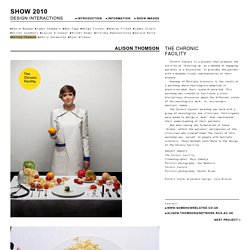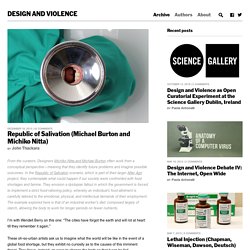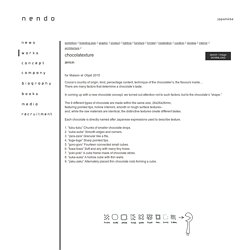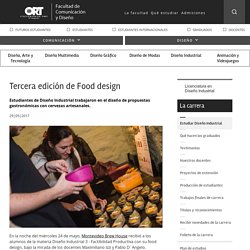

Design Interactions→Alison Thomson→The Chronic Facility. ← The results of this workshop ‘served’ to people with multiple sclerosis. ↑ The purpose of the workshop was to assist in a cross-disciplinary discussion within the group as they all work on different levels, ie. microscopic, abstract, human.

All content © 2010 Royal College of Art Chronic Couture is a project that proposes the activity of ‘dressing up’ as a method of engaging patients in a discussion. It provides the patient with a bespoke visual representation of their disease. Anatomy of Multiple Sclerosis is the result of a workshop where neurologists modelled in plasticine what their research entailed. The Chronic Counter workshop was held with a group of neurologists and clinicians. How does seeing the formulation of these ‘dishes’ affect the patients’ perceptions of the clinicians who created them?
Project Credits The Chronic Facility Cinematographer: Maja Zamodja Portrait photography: Dan Medhurst Chronic Couture Portrait photography: Rachel Brown. Republic of Salivation (Michael Burton and Michiko Nitta) From the curators: Designers Michiko Nitta and Michael Burton often work from a conceptual perspective—meaning that they identify future problems and imagine possible outcomes.

In the Republic of Salivation scenario, which is part of their larger After Agri project, they contemplate what could happen if our society were confronted with food shortages and famine. They envision a dystopian fallout in which the government is forced to implement a strict food-rationing policy, whereby an individual’s food allotment is carefully tailored to the emotional, physical, and intellectual demands of their employment. The example explored here is that of an industrial worker’s diet: composed largely of starch, allowing the body to work for longer periods on fewer nutrients. I’m with Wendell Berry on this one: “The cities have forgot the earth and will rot at heart till they remember it again.”
The good news is that we are on our way to “remembering the earth” once again. Lapin Kulta Solar Kitchen. It is well known that solar kitchens use alternative energy: the sun.

Yet it is not so widely known how the technical parameters of the solar kitchen affect food processing when cooking. Heat is all over the food, and is not only below as in the traditional way of cooking. The time sequence is much more progressive, changing continuously. These two facts affect the taste and texture of prepared food in a surprising and positive way, bringing about a completely different tasting experience. The Lapin Kulta Solar Kitchen Restaurant also plays with several contemporary factors; it is a nature-driven kitchen featuring flexibility and immediacy. THOMAS THWAITES » The Toaster Project. Much has been said elsewhere about The Toaster Project, which I’m really pleased about!

I’ll not try and reproduce it here, except to answer some questions and criticisms (which for the most part are totally welcome). So, firstly, yes, I realise toasting bread over a fire would’ve been a lot easier. But was a piece of toast (or designing a better toaster) really the point of this project? Secondly, yes I realise I cheated quite a lot! Though I really did naively set out with the intention of only using pre-industrial tools and methods, I soon realised that a) it was impossible, and b) by taking things like trains, or using wikipedia, or even not making my own shoes for walking to a mine, I was already in a sense ‘cheating’.
Transformative Appetite. 3D Food Printing. Chocolatexture. For Maison et Objet 2015 Cocoa’s country of origin, kind, percentage content, technique of the chocolatier’s, the flavours inside…There are many factors that determine a chocolate’s taste.

In coming up with a new chocolate concept, we turned out attention not to such factors, but to the chocolate’s “shape.” The 9 different types of chocolate are made within the same size, 26x26x26mm, featuring pointed tips, hollow interiors, smooth or rough surface textures–and, while the raw materials are identical, the distinctive textures create different tastes. Each chocolate is directly named after Japanese expressions used to describe texture. 1.
The Rhythm of Food — by Google News Lab and Truth & Beauty. Exploring food as a form of data expression. Designing the Future of Food.
Tercera edición de Food design - Universidad ORT Uruguay. En la noche del miércoles 24 de mayo, Montevideo Brew House recibió a los alumnos de la materia Diseño Industrial 3 - Factibilidad Productiva con su food design, bajo la mirada de los docentes Maximiliano Izzi y Pablo D´Angelo.

La consigna del proyecto, según explicó el docente Maximiliano Izzi, fue diseñar un nuevo producto alimenticio que acompañe la instancia de tomar una cerveza artesanal. “Para esto, cada equipo debía seleccionar una de las cuatro cervezas que probaron en la degustación y, a partir de allí, ya podían empezar aplicar el proceso de food design, que les llevo dos semanas, desde la presentación de la premisa a la presentación de los proyectos”. En los últimos años la distribución, la compra y la consumición de alimentos ha sufrido grandes cambios, apuntó.
In-Situ. Materials. Food Experience. Critical Food (Tech, Design Fiction, Speculative Design...) Miscellanous.